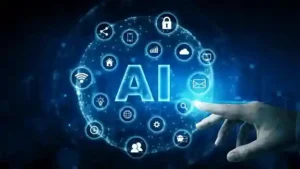The Role of AI in Cybersecurity: Opportunities & Risks

Indeed, the demand for cybersecurity has increased over the years, with a clear possibility of becoming increased in the near future as the world gets more digitalized. Hackers have become wiser, and the tendency of the acts performed by them has also gone up. Enter AI in cybersecurity; in fact, it surfaces as one of the main complications. Well, AI itself creates new and efficient ways of securing systems but in a similar tune brings its own risk.
We are going to discuss opportunities and dangers of using AI in a dynamic war against cyber threats and what things hold for the future.
✅ What is AI in Cybersecurity?
Cybersecurity designers apply machine intelligence in several forms—most notably, ML-to accomplish detection, prevention, and response in the area of cyberattacks. Contrary to conventional software, AI enables a quick analysis of large data sets, learning from that analysis, and decision-making without the help of human intervention.
✅ Opportunities: How AI Helps in Cybersecurity
Here are some of the major benefits of using AI for cybersecurity:
1. Faster Threat Detection
This allows it to see peculiarities like illicit logins and unusual data-filing behavior faster than any average human could.
🧠 Example: In the issue of a hacker attempting to log in with a stolen password from another country, the anomaly in pattern recognition by the AI will automatically block that login request.
2. Predictive Analysis
AI not only distinguishes threats but also anticipates them. By applying machine learning in cybersecurity, it can observe past attacks to envisage future ones before they actually have an effect.
AI cannot know simply threatening events; it can also anticipate the future threats. There are machine-learned systems in cybersecurity that can learn from attacks in the past to expect and prevent future occurrences before the actual attack can happen.
🎯 This helps companies stay ahead of cybercriminals instead of just reacting to them.
3. Automated Responses
AI systems can respond automatically to some attacks, such as shutting down infected devices or blocking suspicious files, without waiting for a human to step in.
🔄 This reduces damage and speeds up recovery time.
4. Improved Security for Large Networks
Big companies deal with thousands of devices and users. AI can monitor all of them at once and detect strange activity instantly, making it easier to secure large networks.
5. AI-Powered Email and Spam Protection
AI can scan emails for phishing links, fake websites, or suspicious language and block harmful messages before they reach your inbox.
⚠️ Risks: Challenges and Dangers of AI in Cybersecurity
While AI offers great tools for protection, it also comes with certain risks and challenges.
1. Hackers Using AI
Another thing worth mentioning is how a company might use AI to defend itself while hackers might use it for the opposite purpose, creating a worm capable of evolving and learning how to get around a firewall or security tool.
🤖 Definitely, AI-powered malware are more harmful and difficult to detect.
2. False Positives and Errors
AI isn’t perfect. Sometimes, it may wrongly flag safe files as threats or miss actual attacks. This can cause businesses to waste time or even lose data.
⚠️ Trusting AI too much without human checks can be risky.
3. Data Privacy Issues
Where the AI systems require huge data to understand and take decisions, such data may consist of quite sensitive user information, which raises concerns regarding its storage and usage.
4. Cost and Complexity
Building and maintaining AI-based security systems can be expensive and complex. Small businesses may find it hard to use AI tools effectively.
5. Lack of Human Judgment
AI can’t understand the full context like humans do. Sometimes, a human analyst is still needed to decide if something is really a threat or not.
🔐 Real-Life Examples of AI in Cybersecurity
Many companies are already using AI for better protection:
-
Threat detection and security advice are offered to the security teams by the IBM Watson for Cybersecurity.
-
The Darktrace AI actually monitors the networks for immediate counteraction to the cyber-attack.
-
Spam, phishing, and malware are detected by AI for Gmail.
These tools are working to make cybersecurity better continuously as they are.
👉 Learn how AI tools are helping content creators in our article on Top 5 AI Tools for Content Creation in 2025.
👉 For a deeper look into AI and cybersecurity, check out this official NIST guide on AI and security.
🧭 The Future of AI in Cybersecurity
The future of cybersecurity will depend heavily on AI. We can expect:
-
More smarter AI tools that learn fast and work even better with humans.
-
Better collaboration between humans and AI to make security decisions.
-
Stricter laws and regulations which protect privacy and control the way in which AI is used.
AI is a really powerful tool combined with good security practices and human intelligence but it is not a magical cure.
✅ Conclusion
Said rapid change is taking place in the way AI is playing a role in cybersecurity. From addressing cyber attacks when they happen to predicting what the next threat would be, AI has wonderful possibilities. At the same time, new risks are also introduced, and those must be managed appropriately.
By using AI wisely—and combining it with expert human knowledge—we can build a safer digital world.


